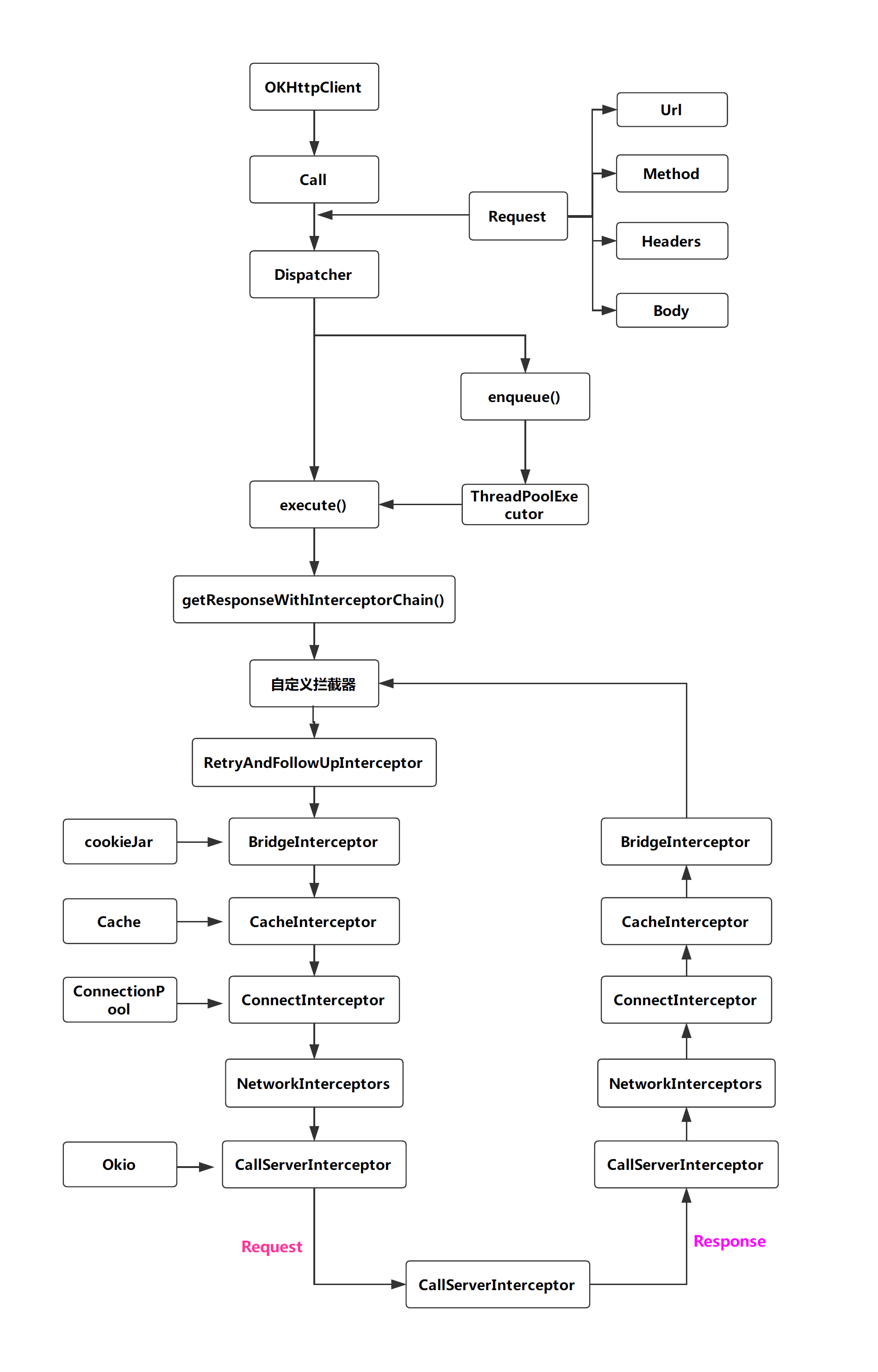前言
Android开发中,常用的第三方网络请求框架有Retrofit,OKHttp,Volley。最近重构项目框架采用的是Kotlin + Retrofit + RxJava,Retrofit的底层实现就是OKHttp实现。本篇文章介绍OKHttp源码执行过程。
请求示例
1.Gradle引入
GRADLE
compile 'com.squareup.okhttp3:okhttp:(insert latest version)'2.GET请求
OkHttpClient client = new OkHttpClient();
String run(String url) throws IOException {
Request request = new Request.Builder()
.url(url)
.build();
Response response = client.newCall(request).execute();
return response.body().string();
}4.OKHttp请求流程
5.源码执行流程
根据上面的执行流程和GET请求,我们来看下源码是如何是如何实现的。
OKHttpClient是什么?
网络请求的工厂,用于发送HTTP请求并且读取响应的一个类。通过new OKHttpClient()方式来创建一个单一的HTTP客户端。我们来分析一波OKHttpClient的源码。
client.newCall(request).execute(); //请求网络核心代码我们来看下OKHttpClient类的newCall(request)方法做了啥。
/**
* Prepares the {@code request} to be executed at some point in the future.
* 准备request网络请求 在将来某个时候执行。
*/
@Override public Call newCall(Request request) {
return new RealCall(this, request, false /* for web socket */);
}网络请求Request的构建很简单。我们的Request类中通过建造者(Builder)模式,将请求的Url(请求地址链接),Method(请求方法),Headers(请求头),Body(请求体)等信息添加到Request对象中。我们可以看到new Call(request)方法很简单返回了RealCall的实例。接下来我们进入RealCall类中一探究竟。
RealCall 实现了Call接口,在Call中我们定义了请求方法。
Call接口:
/**
* 请求方法
*/
Request request();
/**
* 同步请求方法
*/
Response execute() throws IOException;
/**
* 异步请求方法
*/
void enqueue(Callback responseCallback);
/**
* 取消请求调用
*/
void cancel();
/**
* 判断请求调用是否执行
*/
boolean isExecuted();
/**
* 判断请求调用是否取消
*/
boolean isCanceled();
/**
* 克隆一个请求调用
*/
Call clone();
RealCall.构造函数
RealCall(OkHttpClient client, Request originalRequest, boolean forWebSocket) {
final EventListener.Factory eventListenerFactory = client.eventListenerFactory();
//传入的OKHttpClient对象
this.client = client;
//传入的Request请求对象
this.originalRequest = originalRequest;
//是否是webSocket请求,这里默认false
this.forWebSocket = forWebSocket;
//一个可以重故障中恢复的拦截器(出镜很高-->拦截器)
this.retryAndFollowUpInterceptor = new RetryAndFollowUpInterceptor(client, forWebSocket);
}RealCall.excute()
@Override public Response execute() throws IOException {
//1.当前请求已经执行过 抛异常
synchronized (this) {
if (executed) throw new IllegalStateException("Already Executed");
executed = true;
}
//2.捕获当前请求堆栈跟踪变化
captureCallStackTrace();
try {
//3.执行同步网络请求操作(**Dispatcher分发器是什么?**)
client.dispatcher().executed(this);
//4.获取请求返回的结果
Response result = getResponseWithInterceptorChain();
if (result == null) throw new IOException("Canceled");
return result;
} finally {
//5.结束当前网络请求
client.dispatcher().finished(this);
}
}Dispatcher分发器是什么?
执行异步请求时的策略?通俗点来说,我们有很多的异步请求,请求的执行顺序,执行规则都是由分发器决定的,每个分发器的内部有个ThreadPoolExecutor,这是线程池的核心类。作用是什么呢?当然是将线程进行复用,每个请求需要一个线程去执行,当执行完一个请求任务结束之后,重新创建新的线程太消耗性能。不需要在重新创建一个新的线程去执行下一个任务。我们先有这样一个概念,Java的线程池是个很”重”的知识点,改天我们将他’扒个干净’。接下来我们看下Dispatcher类中的请求方法。
同步:
/** 运行同步调用。包括尚未结束的已取消呼叫 */
private final Deque<RealCall> runningSyncCalls = new ArrayDeque<>();
/** 将我们请求添加到同步请求队列中 */
synchronized void executed(RealCall call) {
runningSyncCalls.add(call);
}异步:
/** 运行异步调用。包括尚未结束的已取消呼叫 */
private final Deque<AsyncCall> runningAsyncCalls = new ArrayDeque<>();
synchronized void enqueue(AsyncCall call) {
if (runningAsyncCalls.size() < maxRequests && runningCallsForHost(call) < maxRequestsPerHost) {
runningAsyncCalls.add(call);
executorService().execute(call);
} else {
readyAsyncCalls.add(call);
}每一个请求都创建了一个RealCall实例,而异步请求AsyncCall 是RealCall的内部类,每个Call都需要一个线程去任务,执行Call的过程其实就是执行线程的excute()过程。当Dispatcher接收到一个请求时,Dispatcher负责在其内部维护的线程池中找出空闲的线程去执行其execute()方法。
Response返回
RealCall类中执行请求动作后就通过 Response result = getResponseWithInterceptorChain();返回了服务端响应的结果。
Response getResponseWithInterceptorChain() throws IOException {
// 建立一个完整的拦截器堆栈
List<Interceptor> interceptors = new ArrayList<>();
interceptors.addAll(client.interceptors());
//1.暂且叫它 -->可恢复的拦截器,根据需要进行重定向
interceptors.add(retryAndFollowUpInterceptor);
//2.桥接拦截器
interceptors.add(new BridgeInterceptor(client.cookieJar()));
//3.请求是从内部缓存中发出,缓存拦截器将返回写入到响应缓存中和此请求对应
interceptors.add(new CacheInterceptor(client.internalCache()));
//4.打开客户端与目标服务器的连接-->连接服务器
interceptors.add(new ConnectInterceptor(client));
//5.拦截器链中最后一个拦截器,对服务器进行请求呼叫
interceptors.add(new CallServerInterceptor(forWebSocket));
//6.Boss是我:承载整个拦截器链的具体拦截器链:所有应用程序,拦截器、OkHttp核心、所有网络拦截器,最后是网络调用者。
Interceptor.Chain chain = new RealInterceptorChain(
interceptors, null, null, null, 0, originalRequest);
return chain.proceed(originalRequest);
}核心方法proceed(….)的请求返回核心代码如下。
public Response proceed(Request request, StreamAllocation streamAllocation, HttpCodec httpCodec,
RealConnection connection) throws IOException {
// Call the next interceptor in the chain.
RealInterceptorChain next = new RealInterceptorChain(
interceptors, streamAllocation, httpCodec, connection, index + 1, request);
Interceptor interceptor = interceptors.get(index);
Response response = interceptor.intercept(next);
return response;
}结尾
本篇介绍了OKHttp的源码执行的流程,下篇将对OKHttp网络请求究竟发生了什么?如何得到服务器返回值?以及对OKHttp的核心拦截器将会作详细的介绍。
